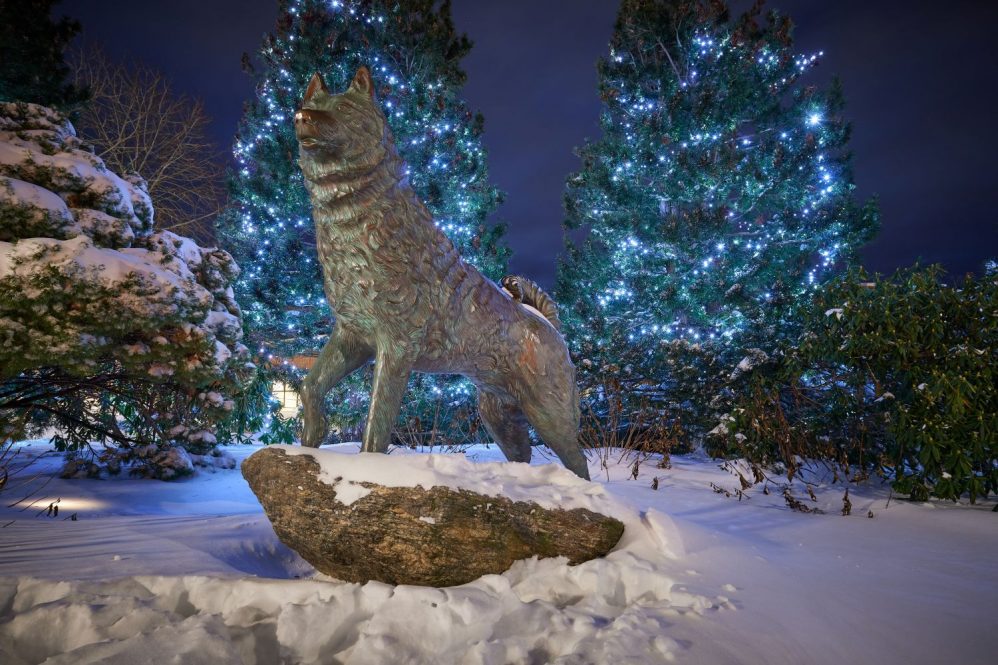Going to a Christmas tree farm with rows and rows of perfectly pruned evergreens is a treasured tradition for many in Connecticut. But with eight main varieties of trees grown in the state, it can be difficult to know which option is the best to choose.
College of Agriculture, Health and Natural Resources tree experts Mark Brand, professor of horticulture, and Tom Worthley, associate extension educator with UConn Extension, explain what kind of trees Connecticut residents can expect to find at their local tree farm and the features to keep in mind when choosing the best tree for your needs.
“People in Connecticut are not going to go out in the woods and find a wild Christmas tree, the way they might in Vermont or Maine,” Worthley says. “All the cut-your-own Christmas trees in our state are going to be farm-grown at a Christmas tree plantation.”
 Barking Up the Right Tree
Barking Up the Right Tree
There are three main categories of evergreen trees grown in Connecticut: pines, spruces, and firs. Within these categories there are multiple species. Namely, white pine, Scotch pine, white spruce, Colorado blue spruce, Norway spruce, Balsam fir, Fraser fir, white fir, and (although not a “true fir”) Douglas-fir.
The type of tree you find at a specific farm is mostly a result of what kind of tree grows well in that farm’s soil based on factors like the nutrient content and drainage.
Firs
You may see a few different fir varieties at Connecticut tree farms this year. Firs tend to last longer than other kinds of evergreens and can usually stay up for four to six weeks.
“In general, the firs have the best needle retention,” Brand says. “So, if you’re a person who’s going to want a tree in the house for the longest period possible, you should probably spend the extra money on a fir.”
- The balsam fir, a native Canadian tree, is the iconic species for Christmas trees thanks to its classic scent and appearance. The needles of this tree lie flat and have a dark green color.
- The Fraser fir is native to the U.S. It’s similar to the balsam fir and does well in Connecticut soil. The main difference between the Fraser and balsam fir is in the Fraser fir’s needles are dense, point upward, and tend to be stiffer. This fir has a lighter green color.
- White firs grow in the western United States. This fir is a favorite for growers and buyers thanks to its citrusy scent. Additionally, because it grows in a very dry area of the country, it is more drought resistant than other varieties, meaning it holds onto its needles well. It has powdery blue needle color.
- Douglas-firs look a lot like the other firs, and like the balsam and Fraser firs, has good needle retention.
Pines
Long-lasting may be the firs’ claim to fame, but pines take top spot when it comes to needle length – their needles are longer than any other group of evergreens used as Christmas trees. Pines also tend to have a shorter lifespan as indoor Christmas trees than other types, lasting about three weeks.
- White pines can only hold one year’s worth of needles, whereas other species hold onto their needles for a few years. This means farmers need to prune these bushy trees more than others to give them the uniform appearance customers look for in a Christmas tree.
- Scotch pines are less popular in the Northeast. They have stiffer needles and a bluer color than the white pines. These trees are more common in the Midwest where firs and spruces have a harder time growing.
Spruces
If you want to choose a tree you can replant outside after the holidays, spruces are the best option since they naturally grow in climates like Connecticut’s. Firs prefer colder, higher altitude environments and are generally a more finnicky plant.
If you do want to plant the tree, pre-dig the hole before the ground is too frozen and keep the tree with a rootball inside as short a time as possible. Like pines, you can expect spruces to last for about three weeks inside.
- Blue spruces have stiff, long, blue-green needles. This may be a good choice if you have a lot of heavy ornaments since the branches won’t sag as much under the weight. But the needles are very sharp, making for a prickly decorating experience.
- The white spruce has a more pungent aroma than the classic balsam fir. These trees also have slightly worse needle retention, which means you might end up with a pile of needles on the floor around your tree if you keep it for too long.

Healthy All Holiday
With any species, there are some general tips for picking a healthy tree that will last through the holiday season.
Generally, trees grown on a farm will have a uniform color. If a tree stands out for being more yellow or has multiple colors on it, that could be a sign the tree is not in the best shape.
If you give an un-cut tree a shake and it is shedding a lot of needles, that might be another sign of poor health. However, some species, particularly spruces, will hold their needles for a few growing seasons, meaning it’s part of their normal lifecycle to eventually drop some of the oldest needles.
“In conditions like we had this summer with extreme drought, some of the spruce trees may have decided ‘It’s not worth carrying these old needles,’ and dropped some of the older ones,” Worthley says. “So, we may see a little bit more needle drop from older needles on twigs than more recent needles just because the tree is doing it for cost efficiency purposes.”
While the adult trees were relatively unscathed by the drought, it may have hurt recently planted trees. This means customers could see a shortage seven to 10 years from now when the trees would have been fully grown and ready to chop down.
 How to Keep a Christmas Tree
How to Keep a Christmas Tree
After choosing your Christmas tree, there are several key things to know about how to keep the tree healthy and safe in your home.
First, get the tree in water right away. You can also make a fresh cut a couple inches from the bottom before putting it into the tree stand.
“Then it’s just a matter of watering it as often as you can,” Worthley says. “You want to keep up with it at the beginning or you’re apt to shorten the amount of usable time the tree can be in place.”
Christmas trees use a lot of water when they first come into the house because the warm, well-watered environment feels a lot like the arrival of spring and shocks the tree’s system.
During the winter, the trees shed excess water from their trunks and branches so it won’t freeze inside them. This makes the wood very dry. So, when the tree comes inside a warm house and has access to water, it begins to take it up rapidly before gradually slowing. Initially, a tree may need its water replenished once or twice a day.
Even if your tree is drinking plenty, it’s still important to keep it away from heat sources and direct sunlight. These conditions can dry the tree out, reducing its lifespan in the house, and creating a fire hazard.
Brand and Worthley also advise getting to farms early to get prime pick of your holiday centerpiece. Since the pandemic and more flexible work schedules, more people sought safe activities like cutting down their own trees. This has led to a tree shortage for the past few years. Brand says he expects this trend to continue.
“I would expect there to be limited supplies this year,” Brand says. “I would suggest people go earlier [rather] than later if they want a good selection, especially larger trees.”
Regardless of the type of evergreen you buy, the “perfect” tree is in the eye of the beholder.
Follow UConn CAHNR on social media



